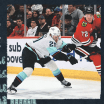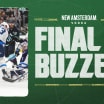PALM DESERT, CA – Game days start early for the American Hockey League Coachella Valley Firebirds coaching staff. Head coach Derek Laxdal is the first to arrive by 6:30 a.m. at the Berger Foundation Iceplex next to Acrisure Arena. His assistant coaches, Brennan Sonne, Stu Bickel and Colin Zunianello, along with video coach Peter Thome, are soon to follow.
The day’s first meeting for the Kraken AHL affiliate kicks off at 7:45, lasting about 10 minutes for the coaches to cover the day’s plans for the power play, faceoffs and defensive-zone breakouts (including morning skate drills and game strategy). Laxdal and his fellow coaches prefer a similar time length for meetings with players throughout the day. They lean hard into rapid-fire video clips to make their points with near-zero chance for players’ attention to waver.
In the first week of December, with two practices (Monday and Wednesday) and two games (Tuesday and Thursday), Laxdal afforded the opportunity to embed with Firebirds coaches and team, providing an inside look at how the Seattle and Coachella Valley hockey operations groups develop Kraken prospects, assure any number of CVF players are ready to be called up ASAP and, yes, constantly strive to win games and attract fans. The Firebirds are currently 13-8-1 after a weekend two-game sweep of Pacific Division rival Calgary, which has the best winning percentage in the entire AHL.
Game Preparation Starts Soon After the Last Game Ends
The purposeful use of video during team meetings and 1-on-1 sessions between coaches and players is a team effort. Laxdal said he creates 130 to 200 videos every game while Bickel clips certain plays of Firebirds’ defensemen, and Zulianello relies on video coach Thome to cut goalie videos with the two in contact on headsets during play. Thome, a former pro goalie himself, said he cuts about 130 to 150 videos across various needs for the coaching staff and players every game. But the CVF head coach doesn’t slack on video chores.
“I'll try and get a period done after the game [and finish early the next morning],” said Laxdal. “A lot of coaches do it differently. I have to watch the game because little things happen defensively. I’ve got to know what the defensemen are doing, and I want to know what all 12 forwards are doing.
“I used to do [video clipping] just for the scoring chances and forechecks, but then you're always going back and seeing what happened at certain points of the game, right? By the time I finished [checking back and forth], I thought, ‘Well, I could have cut the whole game.’ I learned that early. What I do now is cut the whole game. I know ‘Bicks’ is covering the D-men, but when he shows a video to our team, I know in my head that I've seen that play, rather than say, ‘hey, play that again.”
Morning, Game Days
After the usual 7:45 meeting, Sonne is busy working on a video that he will show in about 90 minutes for a power play meeting. He is rapt at his desk, his setup a bit separate from the L-shaped row of desks for the other three coaches. Zulianello and Thome have their backs to Sonne with Bickel, in his first year getting to know Laxdal, sits facing a third wall (no windows in hockey coach offices) but is able to glance in any direction. Bickel is focused on clips that will be used for individual sessions with the defenseman corps he oversees, plus the 5:20 team meeting in which he will talk defense strategy before Laxdal talks offense and overall team mindset.
These are men serious about winning games and developing players, prospects and AHL veterans alike, not putting one mission over the other. The ideal is developing prospects while establishing a winning culture. So far, so good for Bickel and Zulianello, holdovers from Dan Bylsma’s staff that won two straight Western Conference titles. Laxdal and Sonne come from winning programs themselves. By early December, the group of five have clearly bonded and the team, adjusting to a new head coach, is again among the conference leaders. But the seriousness and determination to continue as a top AHL franchise only three years into it is cut with the levity and caring about one another that we all dream about finding in our work lives.
Working the Assistant Coaches Room
To wit the banter in this assistant coaches room throughout the morning (8 to 9:15 before the room is overtaken by the ten players on Sonne’s power play units that night, then again by 9:30 until every coach laces up skates for the morning skate, more lively conversation comes at the 11 a.m. to 1 p.m. range): Topics include Laxdal helping Bickel with car repairs, with the head coach/avid mechanic offering to replace the needed engine part himself. Thome, who advanced to play in the NCAA and ECHL, something the tens of thousands of us in the so-called goalie union could only dream about, is making light of his goaltending skills while talking about that night’s opponent Henderson (NV)’s goalie coach and former NHL goalie, Fred Brathwaite. Zulianello and Brathwaite are friends.
On Thursday’s game morning, Sonne, who is clearly intense about delivering his messages to players and a highly successful juniors coach in his first pro role, is carefully and skillfully (don’t laugh CV coaches) painting a mostly black-suited Nutcracker that all players and coaches are required to complete by Laxdal (and part of a Firebirds holiday initiative). The winsome mat-black Nutcracker gets the group talking car paint jobs with “Zuli,” “Bicks” and “Lax” agreeing it is a great look on certain cars. A bit later, Zulianello, Bickel and Thome (simply nicknamed “Pete”) are quizzing each other on the nicknames of teams in more obscure pro leagues, including the Federal Prospects Hockey League: Danville (IL) Dashers, Elmira (NY) Ooh, no, they were the Mammouth, good guess, but now the River Sharks. Baton Rouge (LA)? Newer team, don’t tell me, right, Zydeco.
Let’s be clear: the banter fills in and around the crevices of a rock wall of coaching duties such as watching/preparing video, meeting with players in side-by-side tutorials on the coach’s laptops and discussing drills for practices (Zulianello and Bickel talked about a type of warm-up shooting suggested by rookie goalie Nikke Kokko).
For his part, Laxdal, who has an office around the corner closest to ice where he can see players come and go toward the training rink and up a level to a state-of-the-art, spacious training room supervised by Strength and Conditioning Coach Brandon Wickett. Laxdal holds individual meetings with prospects and veterans during game-day mornings, while on practice days, he sometimes conducts forward-line meetings with a trio of players. Laxdal is fastidious about keeping a log of his 1-and-1 and line-player meetings, so he answers succinctly when Kraken executives phone him to ask how a certain player or prospect is faring.
Pre-Game, Afternoon
The coaches return after a couple of hours of rest and decompressing. Bickel’s ritual for home games is a long walk with his dog, possible all winter with Coachella Valley weather. The coaches are back by 3 p.m. range with Laxdal earlier. There is no set agenda for ongoing game prep until the 5:20 team meeting in the locker room. As it happens on both the Tuesday and Thursday game days, the Kraken are playing an East Coast road game that starts in the four o’clock hour. Thome rigs the larger screen TV and bench on the wall of the room not occupied by coaches, allowing for some intermittent viewing. Laxdal comes in and out to watch.
Sonne stops his video study to watch a shift featuring recent Firebirds players Mitchell Stephens and Ryan Winterton, who are among five players who started the season on the CVF but have also played games for Seattle. Laxdal praises Stephens for walling off a Carolina opponent to keep possession in the offensive zone for a subsequent scoring chance. Laxdal talked early Tuesday morning about how it takes maybe 25 games for veteran players like Stephens and soon-to-be-Thursday’s game hero, Ben Meyers, to get fully acclimated to the Kraken systems of play, which are reinforced by CVF playing the same way.
The game continues and Winterton earns his first-ever NHL point, assisting on a key insurance goals scored by Brandon Tanev. The Kraken fan-fave makes an effort to retrieve the puck as a Winterton keepsake. “I’ve got goosebumps,” said Sonne, who had been working with Winterton daily (except for NHL call-ups) since training camp.
Pre-Game, Team Meetings, 5:20 p.m.
All players’ eyes are glued to the large-screen monitor at the open end of the U-shaped lockers. Most teammates are sitting at their stalls, while NHL-tested defenseman Cale Fleury and Gustav Olafsson are in the same reclined positions on the center-of-room floor next to each other on both game nights of this week. Thome goes through dense, detailed pre-scout of the night’s opponent; Bickel is commanding as he reviews defensive strategy and some positive-reinforcement plays by Firebirds (rookie Ty Nelson gets audible snaps from teammates for an “eat” or blocked shot).
The meeting finishes with Laxdal showing his curated video. Tuesday, he emphasizes limiting turnovers at the opponent’s blue line and top of the faceoff circles. Thursday, thinking back to a tough Tuesday 4-3 loss in which AHL Henderson played the better first period to take a 2-1 lead, Laxdal said, “We’ve got to get our battle game right off the top here. There’s no dipping your toes in the water to start this game.”




















